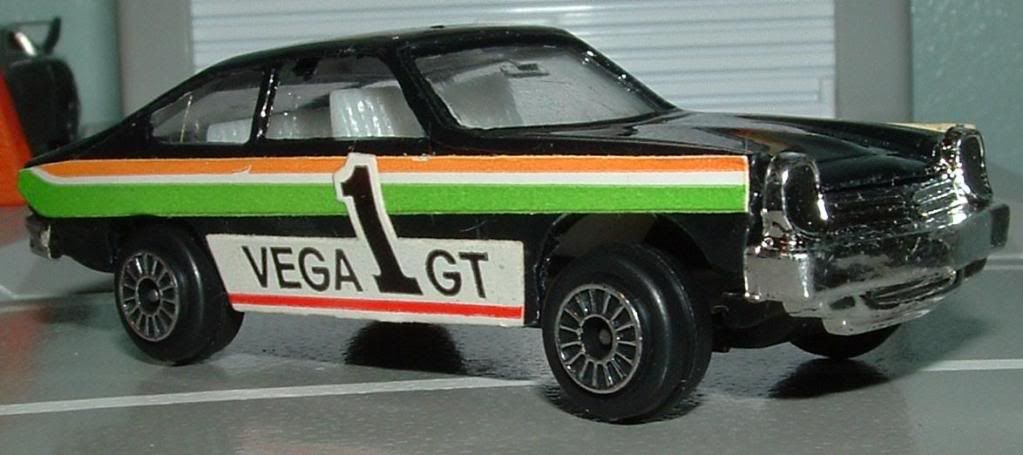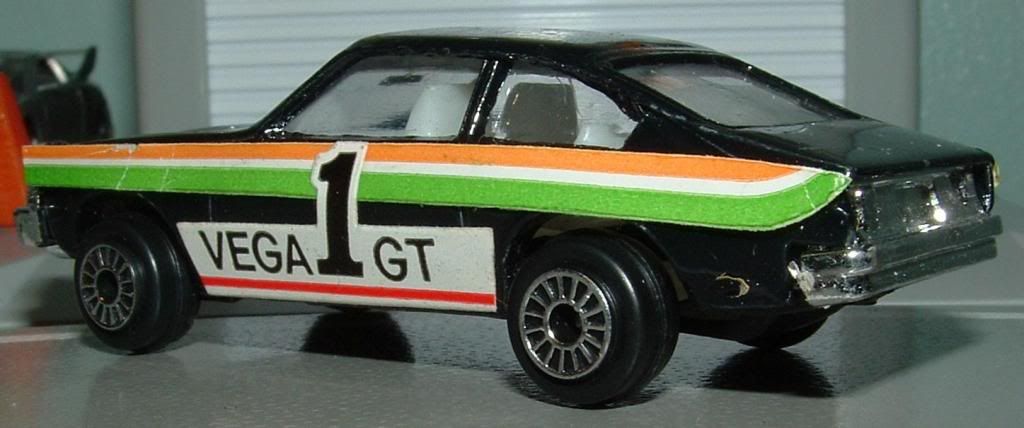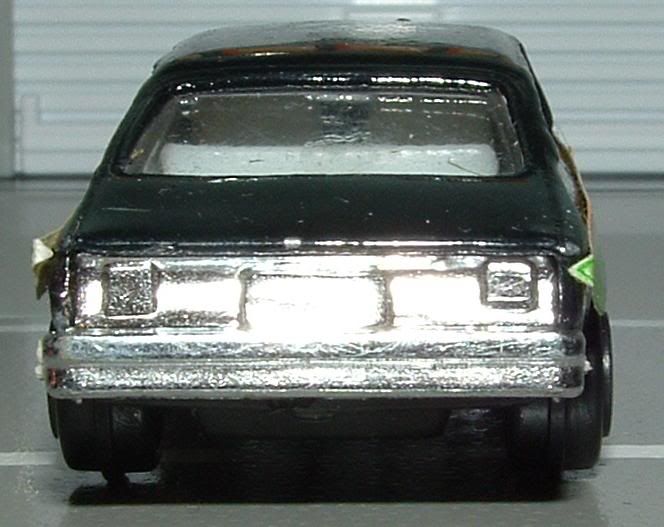
A blog focusing on 1/64 diecast from such popular brands as Hot Wheels, Matchbox, Johnny Lightning, M2 Machines, GreenLight, Tomica, Yat Ming, Majorette, MotorMax, Siku, Corgi, Guisval, Playart, Ertl, Zylmex, Racing Champions, & many more. Swifty's Garage features a daily Car Of The Day and news updates from your favorite brands!
Friday, April 22, 2011
Car Of The Day: April 22, 2011
Today's car of the day is Zylmex's 1974 Chevrolet Vega.
The Chevrolet Vega is a subcompact, four-passenger automobile produced by the Chevrolet division of General Motors for the 1971 through 1977 model years. Introduced September, 1970 as the Vega 2300, its two-door body styles included a hatchback, notchback, wagon, and panel delivery — each using an aluminum-block 140 cu in (2287 cc) inline-4 engine. The car's name derives from the star of the same name. By 1974 the Vega was among the top 10 best-selling American cars. The Cosworth Twin-Cam, a limited production, performance model using an all-aluminum 122 cu in (1994 cc) inline-4 hand-built engine was introduced March, 1975. A poor public perception of the Vega had developed from early model engine and fender corrosion issues. The 1975 Vega-derived Chevrolet Monza, and later, the lower-priced Chevrolet Chevette, offered alternatives. After a three year sales decline, despite efforts to improve the car's image, Chevrolet canceled the Vega and its aluminum engine at the end of the 1977 model year.
For more information and pictures of the real car please visit: Chevrolet Vega
A recent acquisition from bangerkid45 (thanks Jon!) this little Vega joined my collection at this past weekend's Keystone CARnival. The stickers are some of the nicest ones I've ever seen on this particular model, though they are unfortunately losing their adhesive and are falling off the model. But they retain their original vibrant colors and are not sun -faded like so many other examples.
The 1974 model year brought the only major exterior design changes, due to the revised front and rear 5-mph bumper standards. The redesigned front end featured a slanted header panel and recessed headlamp bezels with a louvered steel grille replacing the egg-crate plastic grille. Front and rear aluminum bumpers with inner steel spring (resembling the '74 Camaro) replaced the chrome bumpers, and front and rear license plate mountings were relocated. A revised rear panel on Notchback and Hatchback models had larger single unit taillights and ventilation grills were eliminated on trunk and hatch lids. Overall length was increased six inches (152 mm) compared to 1971-72 models. A 16 gallon fuel tank replaced the 11 gallon tank. The GT sport stripes option was changed — side striping replaced the painted hood/deck stripes. The custom interior's wood-trimmed molded door panels were replaced with vinyl door panels matching the seat trim. In January plastic front fender liners were added after thousands of sets of fenders were replaced under warranty on 1971-74 models. In February the "Spirit of America" limited edition hatchback was introduced featuring a white exterior, white vinyl roof, blue and red striping on body-sides, hood and rear-end panel, emblems on front fenders and rear panel, white "GT" wheels, A70-13 raised white-letter tires, a white custom vinyl interior and red accent color carpeting. 7500 were built through May. Sales peaked for the 1974 model year with 460,374 produced.
The 1975 Vega had 264 changes including H.E.I. (High-energy) electronic ignition and catalytic converter. New options included power brakes, tilt steering wheel, BR78-13B GM-spec steel belted wsw radial tires, and a special custom cloth interior option for the Hatchback and Kammback. In March the Cosworth Vega was introduced featuring an all-aluminum twin-cam inline-4 engine and the first use of electronic fuel injection on a Chevrolet passenger car. All 2,061 '75 models were black with gold accent striping, gold-colored aluminum wheels and black custom vinyl, black custom cloth, or white custom vinyl interiors with a gold "engine turned" dash bezel and gold-plated plaque with Cosworth ID and build number. The Panel Express was discontinued at the end of the model year. Never a big seller, Panel Express sales peaked the Vega's first year at 7,800 units. After leveling off to an average of 4000 per year, only 1525 '75s were sold. Total sales fell to 206,239.
1976 models had 300 changes. A facelift included a revised header panel with Chevy bowtie emblem, a wider grill, revised headlamp bezels —all made of corrosion resistant material, and new tri-color taillights for the Notchback and Hatchback. The 2.3 liter engine, named Dura-built 140, received improved cooling and durability refinements. The chassis received the Monza's upgraded components including the box-section front cross-member, larger rear brakes, and torque-arm rear suspension which replaced the four-link design. The body received extensive anti-rust improvements including galvanized fenders and rocker panels. New models introduced were the GT Estate wagon, the Cabriolet Notchback with a half vinyl roof with opera windows, similar to the Monza Towne Coupe, and a limited edition Nomad Wagon featuring restyled side windows. New options included a Borg Warner 5-speed manual overdrive transmission and a houndstooth type seat trim named "sport cloth" for an additional charge of $18. In January, a "Sky-Roof" with tinted reflectorized sliding glass and 8-track tape player options were added. The Cosworth was offered in eight additional exterior and two additional interior colors, but was canceled in July after only 1446 '76 models.
1977 models were carried over from 1976 with a few revisions and additions. The Notchback was renamed Coupe. The Dura-built 140 engine received a pulse-air system to meet the more strict 1977 Federal emission standards. A similar system secured the Cosworth engine EPA certificate in 1975. The one-barrel version of the engine was dropped, as was the 3-speed manual transmission. A full console was a new option and GTs received blacked-out trim and a revised side striping option.
Subscribe to:
Post Comments (Atom)






No comments:
Post a Comment